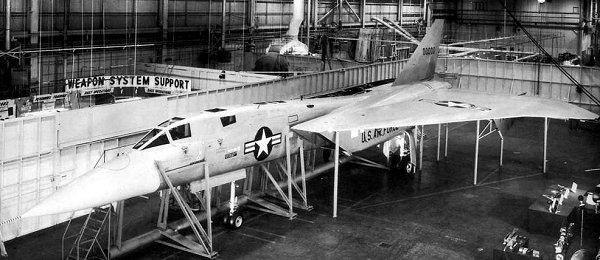The F-108A Rapier was destined to be the last fighter project carried out by North American Aviation, builders of such immortals as the P-51 Mustang and the F-86 Sabre.
The F-108 project was originally known as the LRIX (Long-Range Interceptor, Experimental) and was initiated by the Air Force on October 6, 1955. On June 6, 1957, North American was issued a letter contract for two prototypes of a long-range, high-performance interceptor to be designated F-108A. The company designation for the aircraft was NA-257. It was to be capable of Mach 3 performance and was intended to serve as a long-range interceptor that could destroy attacking Soviet bombers over the poles before they could get near US territory. It was also to serve as the escort fighter for the XB-70 Valkyrie Mach-3 strategic bomber, also to be built by North American. The Air Force expected that the first F-108A would be ready for service by early 1963. An order for no less than 480 F-108s was anticipated.
The F-108A design that North American ultimately produced called for a large delta-winged aircraft powered by a pair of afterburning General Electric J93-GE-3AR turbojets fed by variable inlets mounted underneath the wing roots. The F-108 aircraft was designed for a maximum speed of 1980 mph at 75,550 feet and for a 1020-mile combat radius. The pilot and radar operator sat in tandem individual ejector capsules in the forward cockpit. The aircraft was to be equipped with an extremely sophisticated avionics system, directed by the Hughes AN/ASG-18 search and tracking radar which was to have a range of over 100 miles.
The F-108A was to be armed with three advanced Hughes GAR-9 Falcon missiles housed in an internal weapons bay. The GAR-9 missile was powered by a Lockheed storable liquid-propellant rocket motor which was capable of driving the missile to hypersonic speeds of up to Mach 6 and achieving ranges of up to 115 miles. The GAR-9 missile used semiactive radar homing for midcourse guidance, with passive infrared homing being used for the final run-in to the target.
 A mockup was
inspected in January 1959, with the initial flight being planned for
March 1961. The popular name *Rapier* was assigned on May 15, 1959.
A mockup was
inspected in January 1959, with the initial flight being planned for
March 1961. The popular name *Rapier* was assigned on May 15, 1959.
However, by mid 1959, the Air Force was already beginning to experience some doubts about the high cost of the Rapier program. The primary strategic threat from the Soviet Union was now perceived to be its battery of intercontinental ballistic missiles instead of its force of long-range bombers. Against intercontinental ballistic missiles, the F-108A interceptor would be completely useless. In addition, the Air Force was increasingly of the opinion that unmanned intercontinental ballistic missiles could accomplish the mission of the B-70 Valkyrie/F-108 Rapier combination much more effectively and at far lower cost. Consequently, the F-108A project was cancelled in its entirety on September 23, 1959, before any prototypes could be built. The XB-70 project was also halted, and on December 3, 1959 was cut back to only two prototypes.
The work on the Rapier did not entirely go to waste. The work that Hughes did on the AN/ASG-18 radar was later transferred over to the Lockheed YF-12A interceptor project, and the GAR-9 Falcon (redesignated AIM-47A in 1962) missile originally developed for the F-108A was used to arm the YF-12A.
Specification of F-108A Rapier (estimated):
Two General Electric J93-GE-3AR turbojets, 20,900 lb.s.t. dry, 30,000 lb.s.t. with afterburner. Maximum speed: 1980 mph at 76,550 feet. Service ceiling 80,100 feet, combat ceiling 76,550 feet. Initial climb rate 18,000 feet per minute. Climb to 50,000 feet in 5.4 minutes. Combat radius 1020 miles with three missiles. 2488 miles ferry range. Dimensions: wingspan 57 feet 5 inches, length 89 feet 2 inches, height 22 feet 1 inches, wing area 1865 square feet. Weights: 50,907 pounds empty, 76,118 pounds combat, 102,533 pounds gross. Armed with three Hughes GAR-9 Falcon air-to-air missiles.
|
THE KIT |
|
CONSTRUCTION |
|
COLORS AND MARKINGS |
|
FINAL CONSTRUCTION |
|
CONCLUSIONS |
|
REFERENCES |